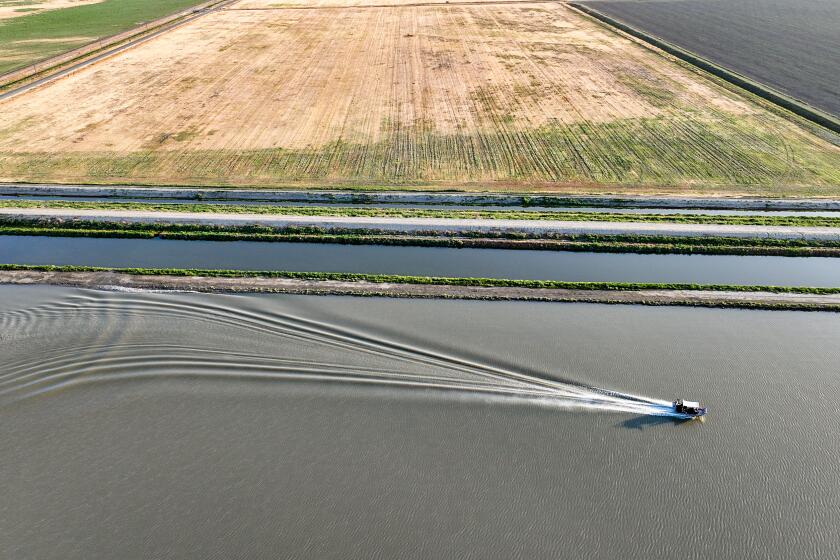Boiling Point: Los Angeles can restrict oil and gas drilling with buffer zones, city attorney says
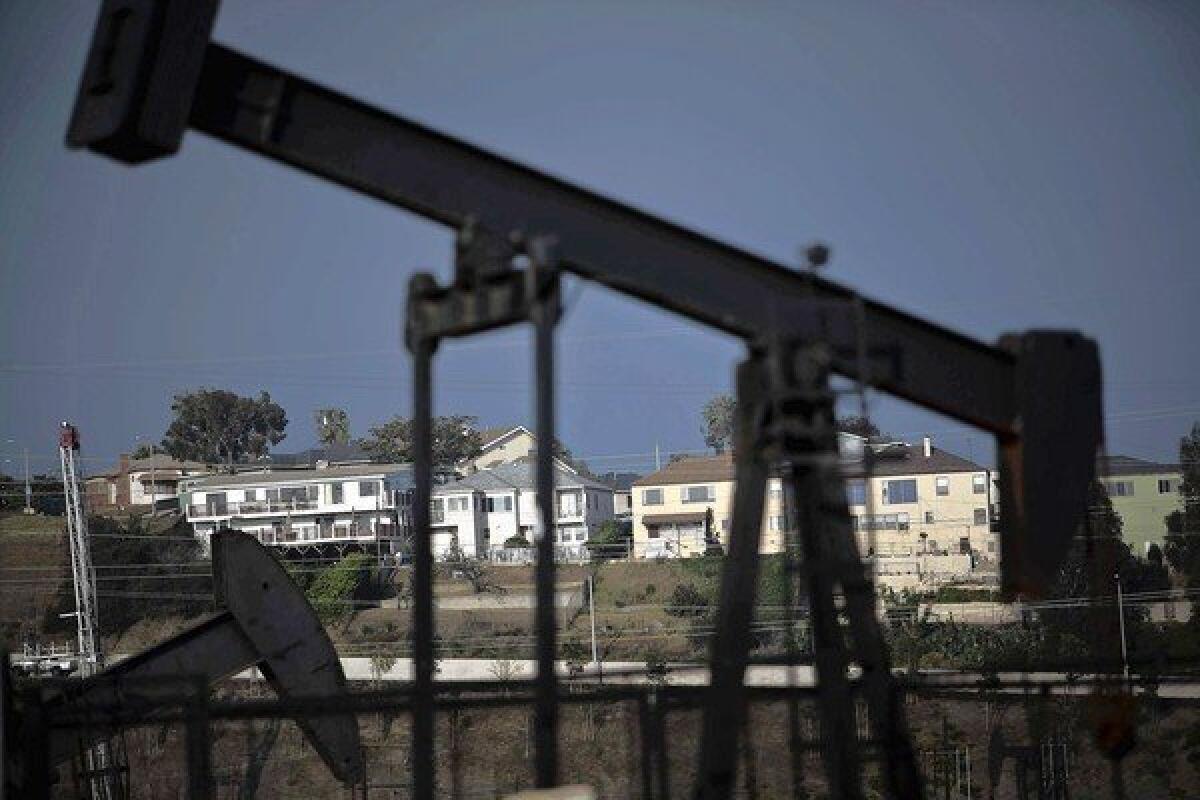
This is the Nov. 19, 2020, edition of Boiling Point, a weekly newsletter about climate change and the environment in California and the American West.
Local government meetings can be dry, drawn-out affairs even during non-pandemic times. Nowadays they typically involve sitting at home and straining to hear a crackly audio feed, or watching a grainy video if you’re lucky.
For the record:
5:24 p.m. Nov. 19, 2020A previous version of this newsletter said Sempra Energy announced a $20-million donation to the Salk Institute for Biological Studies. The donation was $2 million.
Still, I wasn’t going to miss this week’s meeting of the Los Angeles City Council’s Energy, Climate Change and Environmental Justice Committee.
There were two items on the agenda that caught my attention: one about shutting down a gas-fired power plant in a low-income community of color, and one dealing with public-health buffer zones around oil and gas wells.
Toward a more sustainable California
Get Boiling Point, our newsletter exploring climate change, energy and the environment, and become part of the conversation — and the solution.
You may occasionally receive promotional content from the Los Angeles Times.
Both items offered illuminating windows into critical decisions California and the rest of the country must face as the climate crisis worsens. So I settled into my mediocre office chair, turned my computer volume to the max and got ready to take notes.
Here’s a rundown of what was discussed, why it matters and what might happen next.
A war of words over oil wells
The meeting started with public comment, and all 28 commenters wanted to weigh in on the same topic: A proposal to require buffer zones, or “setbacks,” between oil and gas wells and homes, schools and hospitals.
Setbacks are a hot topic, and not just in Los Angeles. Environmental justice activists have pointed to research suggesting that living near oil and gas wells can have serious health consequences. People of color and low-income families are most at risk, as I wrote in August. A few local governments have adopted their own setback rules, most recently Ventura County.
But California’s oil industry has mostly managed to stave off setbacks — and lest anyone forget, L.A. is an oil town.
Last year, the city’s petroleum administrator recommended a 600-foot buffer around existing oil and gas wells and a 1,500-foot setback for new drilling. Existing wells too close to homes would probably need to be shut down.
Rather than act on that recommendation, the City Council asked Mike Feuer, the city attorney, to explore its legal authority to implement setbacks. His office’s conclusions were finally going to be revealed at Tuesday’s meeting.
But first, members of the public engaged in a war of words.
Setback supporters urged City Council to protect disadvantaged communities by requiring 2,500-foot buffer zones. Several commenters alluded to the link between air pollution and COVID-19.
A woman who lives in Wilmington, half a mile from oil and gas extraction, said her mother has asthma and must use a nebulizer — a machine that turns medicine into mist — to breathe each night. She said her community has “waited over five years for the City Council and this committee to respond to our concerns for a safety buffer that truly protects our health.”
“We can no longer sacrifice our health and the health of our children, neighbors, friends to the oil and gas industry,” she said.
Opponents said new restrictions on the fossil fuel industry would eliminate good-paying jobs and increase reliance on foreign oil. They, too, cited the pandemic, saying now is no time to put people out of work and reduce tax revenues.
Several local oil workers spoke from personal experience.
“My sisters and brothers have been working at those facilities during this pandemic, as essential workers, so that everyone else can safely remain in their homes,” said a member of the International Brotherhood of Electrical Workers Local 11.
So what did the city attorney conclude, and how did the council respond? You’ll have to wait to find out, because buffer zones were actually the last item on a lengthy agenda. After public comment, the committee instead discussed …
Shutting down a gas-fired power plant
I wrote recently about Valley Generating Station, a city-owned gas plant in the northeast San Fernando Valley. Local activists have been campaigning to shut down Valley Gen, which is located in a low-income, largely Latino community where residents breathe some of California’s worst air.
The L.A. Department of Water and Power’s recent disclosure of a years-long methane leak at the plant generated outrage. Council President Nury Martinez, whose district includes Valley Gen, introduced a motion at Tuesday’s meeting ordering the DWP to “report back with a plan and timeline” for closing the facility.
“For years we’ve heard calls to shut down our coastal power plants, but nothing about power plants that are directly in the most polluted communities,” she said. “This needs to be an absolute priority.”
Martinez also supported a resolution authorizing the DWP to demolish four 1950s-era smokestacks at the power plant that tower over Pacoima and Sun Valley but haven’t been used since the early 2000s. She called them “a painful reminder to our local residents that we don’t get to have beautiful oceanside views, or even scenic views of our local mountains.”
“Instead there’s a skyline of nothing but old smokestacks that remind us of the emissions that we have to breathe,” she said.
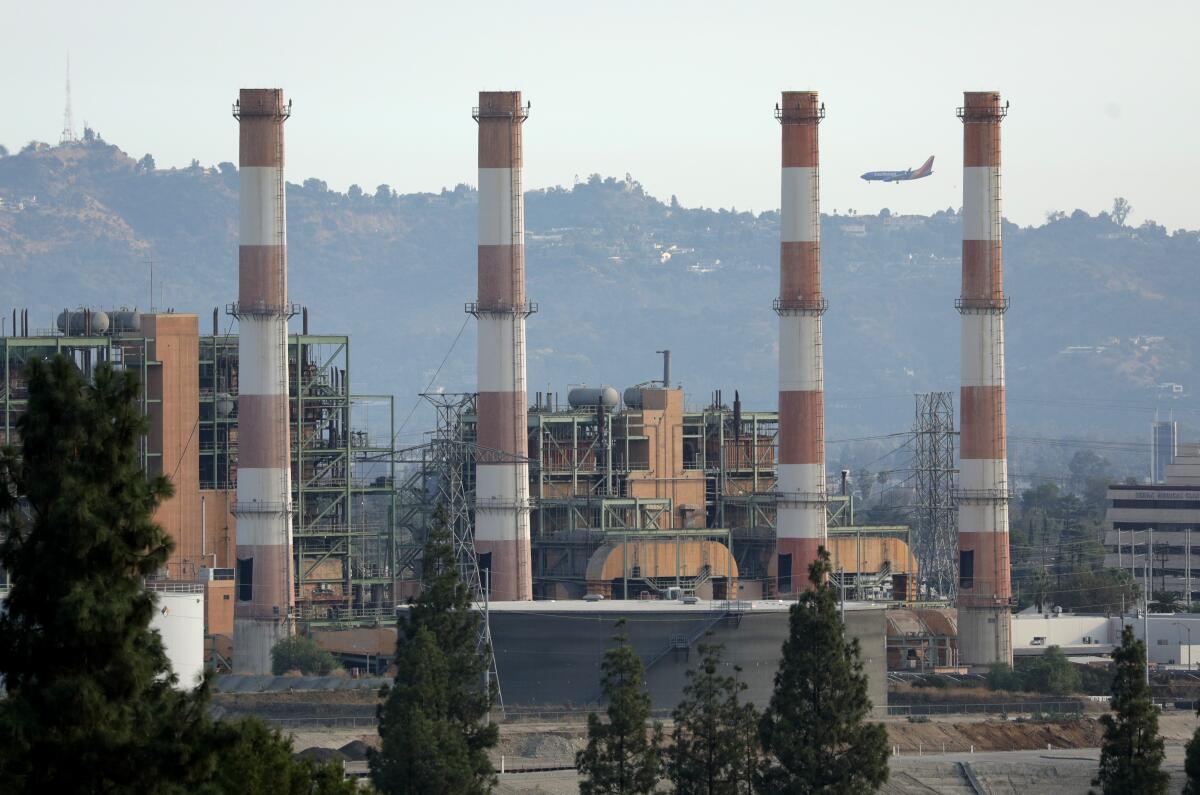
Tearing down the stacks will be easy compared with decommissioning the generating station; DWP officials have said Valley Gen will be critical for meeting the city’s power needs during the transition to renewable energy. Rolling blackouts across other parts of the state this summer dramatized the risks of ditching natural gas without the right kinds of climate-friendly power to replace it.
Los Angeles officials are treading carefully, knowing their success or failure in phasing out fossil fuels could help determine whether others follow their lead. A long-awaited 100% renewable energy study conducted with scientists at the National Renewable Energy Laboratory is expected to be finalized early next year, the DWP’s Louis Ting said Tuesday.
For Martinez, that day can’t come soon enough. The committee passed her motion unanimously.
Back to buffer zones
Two hours into the meeting, the legal mystery came to an end: Los Angeles has the authority to require buffer zones around oil and gas wells, the city attorney’s office concluded.
“Any zoning ordinance enacted by the city will likely result in litigation, but our office will defend in court a carefully crafted setback ordinance backed up by a strong administrative record,” said Jennifer Tobkin, a deputy city attorney.
Still, there’s no guarantee L.A. will move forward with buffer zones. As soon as the city attorney’s office finished its report, Councilman Paul Krekorian splashed cold water on the idea, citing the likelihood of lawsuits.
“I do not want to be the one that has to approve a settlement with oil companies, where we take general fund money that would otherwise be spent on services in front-line communities in the city of Los Angeles,” Krekorian said.
“As eager as we are to move forward on this, I think it’s really important that we be mindful,” he added. “The last thing we want to do is subsidize oil companies with public money.”
It’s been no easier getting setbacks approved at other levels of government. State lawmakers recently rejected a bill that would have required buffer zones statewide. Los Angeles County issued a draft ordinance in April that recommends a 500-foot setback from residences, but there’s been no update since then. California’s oil and gas regulatory agency, known as CalGEM, is drafting rules to protect the health of communities near drilling sites, which may or may not include buffer zones.
This is all part of a broader debate about environmental justice and the best ways to tackle climate change while making sure front-line communities benefit from cleaner air, water and soil. California is at the leading edge of this debate, but it’s playing out more and more across the country and will probably accelerate under the Biden administration.
In Los Angeles, action could be coming soon. The City Council’s energy and climate committee is slated to keep discussing setbacks at its Dec. 1 meeting.
Until then, here’s what’s happening around the West:
TOP STORIES
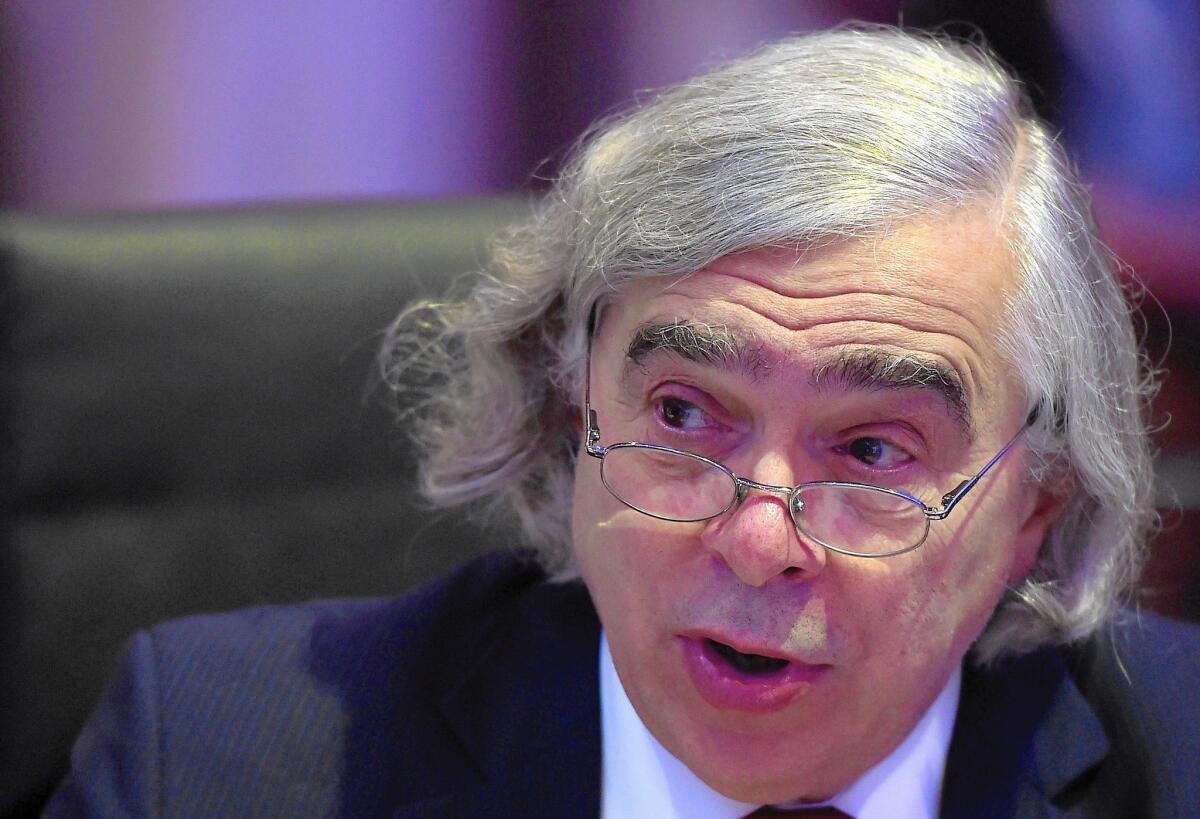
With Joe Biden two months from taking office, the battle over natural gas that’s been playing out in California is poised to go national. I wrote about the tension between activists who want a total phaseout of fossil fuels and centrists who say gas — which is less polluting than coal but contributes to the climate crisis — still has a role to play. Here’s my story, which focuses on the “Green Real Deal”-style policies espoused by Ernest Moniz, rumored to be a top candidate for Biden’s energy secretary.
I’ve done a decent amount of reporting on pro-fossil-fuels advocacy groups that claim to represent regular people but are funded by fossil fuel companies. It’s not easy reporting. So I was especially impressed by this superb story by the New York Times’ Hiroko Tabuchi about FTI Consulting. For years, the global firm has “helped design, staff and run organizations and websites funded by energy companies that can appear to represent grass-roots support for fossil-fuel initiatives,” Tabuchi writes.
Giant sequoias are adapted to live with flame — but not the kinds of flames California has seen recently. My colleague Bettina Boxall wrote this gut punch of a story about the Castle fire killing hundreds — or maybe more than 1,000 — sequoias on the western slope of the Sierra Nevada, and why more controlled burns are probably needed as the planet heats up.
Enjoying this newsletter? Consider subscribing to The Times
Your support helps us deliver the news that matters most, and makes newsletters like Boiling Point possible. Become a Los Angeles Times subscriber.
ALL ABOUT CLEAN TRANSPORTATION
In a fascinating development, Tesla, Uber and a bunch of electric utilities have joined a new trade association that says it will lobby for every car sold in the U.S. to be electric by 2030. More details here from the Atlantic’s Robinson Meyer; the utilities involved include Pacific Gas & Electric and Southern California Edison. You may recall that Gov. Gavin Newsom recently set a goal of ending the sale of gasoline-powered vehicles in California by 2035, so we’re talking about an even more ambitious timeline here.
In related news, Ford is launching a line of electric commercial vans as part of its $11.5-billion investment in EVs. The Times’ Russ Mitchell reports that the automaker is counting on delivery and construction companies, the main buyers of commercial vans, to realize how much money they’ll save long term on fuel costs by ditching the internal combustion engine.
Don’t expect the Biden administration to drop tens of billions of dollars to prop up California’s high-speed rail project. That’s the key takeaway from this story by The Times’ Ralph Vartabedian, who writes that the president-elect’s love of Amtrak may not translate to federal rescue for a project with an $80-billion funding shortfall that has faced engineering and legal challenges.
AROUND THE WEST
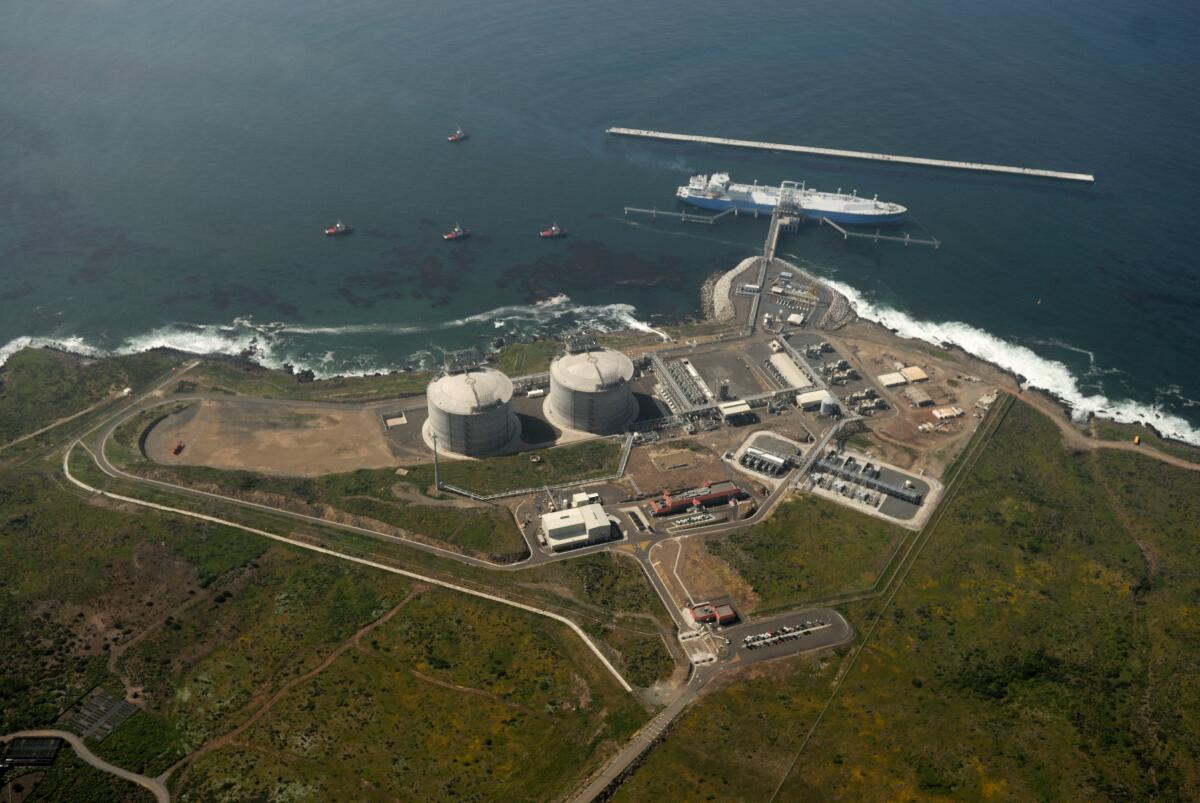
Mexico will allow Sempra Energy to build a $1.9-billion liquefied natural gas export terminal in Baja California. The decision by President Andrés Manuel López Obrador, which followed a year of haggling with San Diego-based Sempra, will allow for more gas produced in the American West to be shipped to Asian markets, as Rob Nikolewski reports for the San Diego Union-Tribune.
Sempra, which counts Southern California Gas Co. as a subsidiary, announced a $2-million donation to the Salk Institute for Biological Studies, which is trying to create plants that absorb more carbon. Here’s Rob’s story. A few days later, Amazon founder Jeff Bezos gave $30 million to the Salk Institute, as the Union-Tribune’s Gary Robbins reported. It was a small fraction of $791 million in donations to climate-focused groups unveiled by Bezos; he’s pledged to spend $10 billion to help solve climate change.
As long as we’re talking about ultra-wealthy individuals, let’s check in on Warren Buffett. The governors of California and Oregon announced a deal this week to demolish four aging dams on the Klamath River, following a federal decision that could have derailed the plan, as the AP’s Gillian Flaccus reports. The deal is a win for Buffett’s Berkshire Hathaway Energy, which doesn’t get much electricity from the dams and would rather get rid of them than install costly fish ladders to protect aquatic life.
CALIFORNIA BURNING
Pacific Gas & Electric is getting a new CEO. After several months of interim leadership, the beleaguered utility named Patti Poppe as its latest chief executive, J.D. Morris reports for the San Francisco Chronicle. Poppe currently leads Michigan’s largest electric and gas utility, Consumers Energy; here’s a profile from last year by Bridge Michigan’s Jim Malewitz, which explores Poppe’s transition from climate skeptic to leading proponent of renewable energy. She’ll have her work cut out for her at PG&E.
Speaking of PG&E, California isn’t the only state where utility infrastructure is igniting wildfires. In Washington, the Seattle Times’ Hal Bernton reports, a series of destructive blazes sparked by power lines has officials looking at California and asking: Do we need to start shutting off electricity to keep people safe, too? In other fire-prevention news, the San Francisco Chronicle’s Matthias Gafni explored the little-known history of an 800-mile firebreak that once ran along the slope of the Sierra Nevada.
After a fire, watching wildlife reemerge can offer signs of hope. My colleague Hayley Smith wrote about how the landscape is responding two months after flames tore through Sonoma County’s Hood Mountain Regional Park. “An amazing thing after a wildfire is to see how many holes in the ground there are,” a biologist told her, adding that foxes, spiders and lizards are known to go underground to avoid flames. “I have this mental picture of all these different creatures crowding into someone’s den.”
What do you want to know?
When you think about California’s climate future, what comes to mind? What keeps you up at night, and what gives you hope or gets you excited? What do you want to understand, and what should I?
This newsletter is for you, to help you understand how we’re changing our world and what we can do about it, and I want to hear your questions, concerns and ideas. Email me or find me on Twitter.
ONE MORE THING
If you’re sick of sitting at home all day to protect yourself from COVID-19, check out these glorious photos of Yosemite National Park’s fall foliage covered in snow, via SFGate’s Ashley Harrell. Or read about Emily Harrington becoming the first woman to free-climb the Golden Gate route on Yosemite’s El Capitan, a 3,000-foot granite wall, in a single day.
“There was a part of me that wanted to give up and quit,” Harrington said. “But this other part of me was like, this is why you’re here. It’s supposed to be hard. You owe it to yourself to try again.”
We’ll be back in your inbox next week. If you enjoyed this newsletter, please consider forwarding it to your friends and colleagues.




